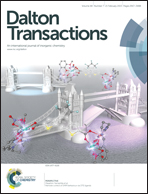Carbon monoxide release properties and molecular structures of phenylthiolatomanganese(i) carbonyl complexes of the type [(OC)4Mn(μ-S-aryl)]2†
Abstract
Several phenylthiolatomanganese carbonyl complexes of the type [(OC)4Mn(μ-SR)]2 (R = Ph (1a), C6H4-4-CH3 (1b), C6H4-4-CF3 (1c), C6H4-4-F (1d), C6H4-4-Cl (1e), C6H4-4-OMe (1f), C6F5 (1g), and CH2C6H4-4-Cl (1h)) have been prepared via the reaction of Mn2(CO)10 with diaryldisulfane or via the reaction of [(OC)5MnBr] with arylthiols. These complexes lose two carbon monoxide molecules quite easily yielding tetranuclear [(OC)3Mn(μ3-SR)]4 (2). Derivatives with fluoro-substituted aryl groups commonly form mixtures of dinuclear 1 and tetranuclear 2 which can quantitatively be converted to 2 by heating of the corresponding reaction mixtures. A unique trinuclear structure is found for the mesityl derivative [(OC)4Mn(μ-SMes)]3 (3) which is maintained in solution as verified by IR and NMR spectroscopy. Traces of an already known dinuclear by-product of the type [(OC)3Mn(μ-SC6H3(-4-Me)-2-SC6H4-4-Me)]2 (4) have been structurally characterized. The suitability of [(OC)4Mn(μ-SPh)]2 (1a) as a CO releasing molecule (CORM) for the administration of carbon monoxide has been studied. Two CO molecules are released upon dissolving in strongly Lewis basic solvents L, yielding [(OC)3Mn(L)(μ-SPh)]2, which liberates all the remaining CO molecules upon irradiation (photoCORM behavior).
![Graphical abstract: Carbon monoxide release properties and molecular structures of phenylthiolatomanganese(i) carbonyl complexes of the type [(OC)4Mn(μ-S-aryl)]2](/en/Image/Get?imageInfo.ImageType=GA&imageInfo.ImageIdentifier.ManuscriptID=C4DT03567D&imageInfo.ImageIdentifier.Year=2015)

 Please wait while we load your content...
Please wait while we load your content...